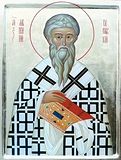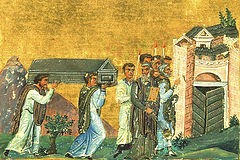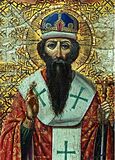

| Previous day | Next day |
| Old Style
January 29
|
Saturday |
New Style
February 11
|
| Fast-free Week. Tone 1. | No fast.
|
![]() Translation of the relics of Hieromartyr Ignatius the God-bearer, bishop of Antioch (107).
Translation of the relics of Hieromartyr Ignatius the God-bearer, bishop of Antioch (107).
Martyrs Romanus, James, Philotheus, Hyperechius, Abibus, Julian, and Paregorius, at Samosata (297). Hieromartyrs Silvanus, bishop of Emesa, the deacon Luke, and the reader Mocius (Mucius) (312). St. Lawrence, recluse of the Kiev Caves and bishop of Turov (1194). Sts. Gerasimus (ca. 1441-1467), Pitirim (1455) and Jonah (1470) bishops of Perm. Synaxis of the Saints of Komi. Synaxis of the Saints of Ekaterinburg. St. Ignatius, bishop of Smolensk (1210). St. Andrew (Rublev), iconographer, of the Spaso-Andronikov Monastery (Moscow) (1430).
Martyrs Sarbelus [Thathuil] and his sister Bebaia, of Edessa (98-138) St. Barsimaeus the Confessor, bishop of Edessa (2nd c.). St. Aphrahates the Persian, hermit, of Antioch (370). St. Gildas the Wise, abbot, of Rhuys, Brittany (ca. 570). St. Severus (Sulpitius I), bishop of Bourges (591). St. Ashot Kuropalates of Tao-Klarjeti, Georgia (829). New Martyr Demetrius of Chios, at Constantinople (1802).
Thoughts for Each Day of the Year
According to the Daily Church Readings from the Word of God
By St. Theophan the Recluse

310
Saturday. [II Tim. 3:1–9; Luke 20:45–21:4]
Who are those having a form of godliness, but denying the power thereof? (II Tim. 3–5). Who are those others, ever learning, and never able to come to the knowledge of the truth? (II Tim. 3:7). The former are those who maintain all the external routines in which a godly life is manifested, but who do not have a strong enough will to maintain their inner dispositions as true godliness demands. They go to church and stand there readily. But they do not make the effort to stand with their mind before God continuously and to reverently fall down before Him. Having prayed a bit, they release the reins of the control of their mind; and it soars, circling over the entire world. As a result, they are externally located in church, but by their inner state they are not there: only the form of godliness remains in them, while its power is not there. You must think about everything else in this manner.
The latter are those who, having entered the realm of faith, do nothing but invent questions—“What is this? What is that? Why this way? Why that way?” They are people suffering from empty inquisitiveness. They do not chase after the truth, only ask and ask. And having found the answer to their questions, they do not dwell on them for long, but soon feel the necessity to look for another answer. And so they whirl about day and night, questioning and questioning, and never fully satisfied with what they learn. Some people chase after pleasures, but these chase after the satisfaction of their inquisitiveness.
Articles
 St Pitirim the Bishop of PermSaint Pitirim, Bishop of Great Perm, was chosen and consecrated to the See of Perm after the suffering and death of St Gerasimus of Perm. |
 Saint Ignatius, Wonderworker and Bishop of SmolenskSaint Ignatius was the first bishop of Smolensk. |
 Saint Aphraates of PersiaSaint Aphraates, a Persian who came to believe in Christ, disavowed his illustrious lineage and left his pagan countrymen by going to Edessa, and then to Antioch. |











